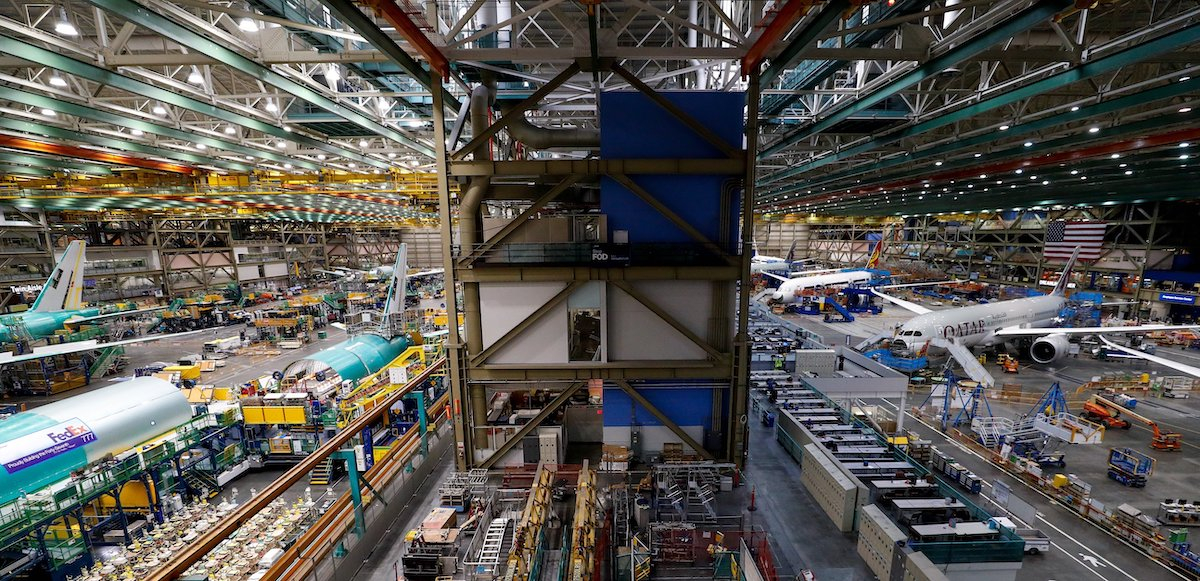An Electrician’s Dispatch: Solidarity at 90 Feet

Boeing’s Everett Production Facility in Everett, Washington. Replacing ceiling lights is hot work, so we brought a thermometer with us and paraded it by the foreman. Photo: AP/Jennifer Buchanan.
Last summer I was working at the Boeing factory in Everett, Washington, on a four-man electrical crew, replacing the existing lights with new LEDs. Our work area was 90 feet off the ground, maybe 20 feet below the roof decking, with no air circulation. You could feel the heat radiating from the ceiling pan.
Our crew has safety discussions every morning. Back in May we had discussed Washington’s heat laws—exposed workers are entitled to water and, if the temperature goes above 90 degrees, an additional rest break.
As the summer heated up, one of our crew members brought in a digital thermometer to check the actual temperature where we were working, not just the weather app. We paraded it by the foreman, as if to say, “We’re keeping a close eye on the situation.”
All summer we never crossed the 90-degree mark, though we came within two degrees. Still, one day a crew member reached his own limits. He notified the foreman and was allowed to come down and take a break, then redirected to a task in a milder climate.
Our time up there is very valuable—management has to coordinate with Boeing day by day for access to the “crane space” above the factory floor. Credit to our foreman: he toed the line on our behalf, prioritizing safety over production.
WINTER HEAT
When we think of heat exposure, we often assume summertime and outdoors. But in another incident, we were performing the same work in a different building in the middle of winter.
This building was used for painting plane parts and had to maintain a baseline temperature which, on the factory floor, was fairly mild. However, the heaters were located in the high bays of the building—our working space—and capable of blasting the heat.
To make things worse, because of lead and hexavalent chromium exposure (a byproduct of plane paint and known lung carcinogen), we had to work in Tyvek suits with respirators. The work was hot and miserable, and it probably slowed us down by 50 percent.
We gave it a go, but concluded these conditions were not safe. We as a crew—foreman included—refused to perform any work until the heaters were turned off.
This contractor was enjoying a seven-year streak with no recordable injuries at this location, an achievement the company was guarding closely. This dynamic allowed us to enforce safety without fear of retaliation. We got those heaters turned off.
BREAK TIME CONFLICT
Same location, same contractor, in 2019: all crews were working eight-hour shifts except one. This crew was working a 10-hour shift, which entitled them to a third break, but they had decided to work through it in exchange for leaving early.

SUPPORT LABOR NOTES
BECOME A MONTHLY DONOR
Give $10 a month or more and get our "Fight the Boss, Build the Union" T-shirt.
State law dictates a 10-minute break in every four-hour block—typically a morning break and an afternoon break. At this site, all the crews had agreed to combine these into a 20-minute morning break. But the 10-hour crew should still have gotten a third break in the afternoon.
The steward noticed the crew skipping a break and brought it up with management. But instead of addressing just that crew, the next morning management announced that everyone’s breaks would be split up into two 10s.
The catch was that the afternoon break would occur 10 minutes before quitting time. This was already a time that workers spent putting away their tools, washing up, and getting ready to catch the shuttle out. Nobody liked this whatsoever.
The steward reported it to the local’s business manager, who scheduled a visit to speak to the members. We were all expecting to hear him say the contractor had agreed to put the second break closer to the midpoint between lunch and quitting time. What we got instead was, “They’re within their rights to schedule the second break whenever they want.”
Clearly the union hall wasn’t going to help. But we had one trick up our sleeve: in our contract overtime is optional. Our employer needed OT to get the job done on time. They didn’t get it. Company-wide, we all left after eight hours.
Ultimately the job got done, albeit behind schedule. It was hard to tell if there was any impact at all until a month later when I was installing conduit in a trench and the general foreman approached.
“Can you work 10-hour shifts for the next couple of weeks?” he asked.
“I don’t know,” I said. “What’s the break schedule?”
He assured me we would get all our allotted breaks. And it wasn’t long thereafter that the break schedule returned to how it had been in the first place.
Jeff Marshall is a member of IBEW Local 191 in Everett, Washington.
